Faber MAES42SS, MAES48SS, MAES36SS Installation Guide
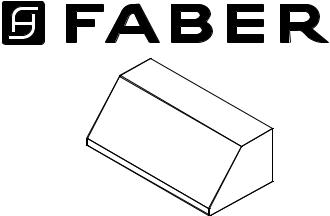
MAESTRALE
Wall Mount Canopy Rangehood
• Installation Instructions
• Use and Care Information
READ AND SAVE THESE INSTRUCTIONS
The Installer must leave these instructions with the homeowner. The homeowner must keep these instructions for future reference and for local electrical inspectors' use.
READ THESE INSTRUCTIONS BEFORE YOU START INSTALLING THIS RANGEHOOD
WARNING: - TO REDUCE THE RISK OF A RANGE TOP GREASE FIRE:
a) Never leave surface units unattended at high settings. Boilovers cause smoking and greasy spillovers that may ignite. Heat oils slowly on low or medium setting.
b) Always turn hood ON when cooking at high heat or when flambeing food
(i.e. Crepes Suzette, Cherries Jubilee, Peppercorn Beef Flambé).
c) Clean ventilating fans frequently. Grease should not be allowed to accumulate on fan or filter. d) Use proper pan size. Always use cookware appropriate for the size of the surface element.
WARNING: - TO REDUCE THE RISK OF INJURY TO PERSONS IN THE EVENT OF A RANGE TOP GREASE FIRE, OBSERVE THE FOLLOWING (*):
a) SMOTHER FLAMES with a close-fitting lid, cookie sheet, or metal tray, then turn off the burner.
BE CAREFUL TO PREVENT BURNS. If the flames do not go out immediately EVACUATE AND CALL THE
FIRE DEPARTMENT.
b) NEVER PICK UP A FLAMING PAN - You may be burned.
c) DO NOT USE WATER, including wet dishcloths or towels - a violent steam explosion will result. d) Use an extinguisher ONLY if:
1) You know you have a Class ABC extinguisher, and you already know how to operate it.
2) The fire is small and contained in the area where it started. 3) The fire department is being called.
4) You can fight the fire with your back to an exit.(*) Based on “Kitchen Firesafety Tips” published by NFPA.
ALL WALL AND FLOOR OPENINGS WHERE THE RANGEHOOD IS INSTALLED MUST BE SEALED.
This rangehood requires at least 24" of clearance between the bottom of the rangehood and the cooking surface or countertop. This minimum clearance may be higher depending on local building code. For example, for gas ranges, a minimum of 30" is recommened and may be required. Overhead cabinets on both sides of this unit must be a minimum of 18" above the cooking surface or countertop. Consult the cooktop or range installation instructions given by the manufacturer before making any cutouts.
AVERTISSEMENT - POUR MINIMISER LE RISQUE D’UN FEU DE GRAISSE SUR LATABLE DE CUISSON : a) Ne jamais laisser un élément de la table de cuisson fonctionner sans surveillance à la puissance de chauffage maximale; un renversement/ débordementdematièregraisseusepourraitprovoqueruneinflammationetlegénérationdefumée.Utilisertoujoursune puissance de chauffage moyenne ou basse pour le chauffage d’huile. b) Veiller à toujours faire fonctionner le ventilateur de la hotte lors d’une cuisson avec une puissance de chauffage élevée ou lors de la cuisson d’un mets à flamber (i.e.
Crepes Suzette, Cherries Jubilee, Peppercorn Beef Flambé). c) Nettoyer fréquemment les ventilateurs d’extraction. Veiller
à ne pas laisser de la graisse s’accumuler sur les surfaces du ventilateur ou des filtres. d) Utiliser toujours un ustensile de taille appropriée. Utiliser toujours un ustensile de taille adapté à la taille de l’élément chauffant.
AVERTISSEMENT: - POUR PRÉVENIR LES BLESSURES EN CAS DE FEU SUIVRE LES RECOMMANDATIONS SUIVANTES (*): a) ÉTOUFFEZ LE FEU avec un couvercle métallique et fermez le brûleur. Si le feu ne s'éteint pas tout de suite, QUITTEZ LES LIEUX ET APPELEZ LES POMPIERS. b) NE TOUCHEZ JAMAIS UNE CASSEROLE EN FLAMMES. c) N'UTILISEZ JAMAIS DE L'EAU ou un torchon mouillé pour éteindre le feu - ce qui pourrait causer une explosion de vapeur. d) N'utilisez un extincteur que si: 1. Vous avez un modèle ABC et vous connaissez bien son mode d'emploi. 2. Le feu est petit et peu répandu. 3. Les pompiers sont déjà prévenus. 4. Vous avez une sortie derrière vous. (*) Basé sur la "cuisine Firesafety incline" édité par NFPA.
TOUTE OUVERTURE DANS LE MUR OU LE PLANCHER À PROXIMITÉ DE LA HOTTE DOIT ÊTRE SCELLÉ
Gardez 24 po. de hauteur entre le bas de la hotte et la surface de cuisson. Cette hauteur minimum peut être plus haute suivant le code municipal. Par exemple, les cuisinières à gaz peuvent requérir 30 po. de hauteur. Les armoires au-dessus ne dépasseront pas 13 po. de profondeur. Les armoires au-dessus de chaque côté devront être au moins à 18 po. au-dessus de la surface de cuisson. Consultez la fiche technique avant de découper les armoires.
Version 09/12Page 1

VENTING REQUIREMENTS
Determine which venting method is best for your application. Ductwork can extend either through the wall or the roof.
The length of the ductwork and the number of elbows should be kept to a minimum to provide efficient performance. The size of the ductwork should be uniform. Do not install two elbowstogether. Useducttapetosealalljointsintheductwork system. Use caulking to seal exterior wall or floor opening around the cap.
Flexible ductwork is not recommended. If it is used, each foot of flexible ductwork used is equivalent to two feet of straight metal ductwork when calculating the ductrun length. Thus, a flexible elbow equals two standard elbows.
Make sure there is proper clearance within the wall or floor for exhaust duct before making cutouts. Do not cut a joist or stud unless absolutely necessary. If a joist or stud must be cut, then a supporting frame must be constructed.
FOR MORE SPECIFIC DUCTWORK INFORMATION, GO
TO PAGE 4.
WARNING - To Reduce The Risk Of Fire, Use Only Metal
Ductwork.
Cold Weather installations
An additional back draft damper should be installed to minimize backwardcoldairflowandanonmetallicthermalbreakshould be installed to minimize conduction of outside temperatures as part of the vent system. The damper should be on the cold air side of the thermal break. The break should be as close as possible to where the vent system enters the heated portion of the house.
!WARNING
•VentingsystemMUSTterminateoutsidethe home.
•DO NOT terminate the ductwork in an attic or other enclosed space.
•DO NOT use 4" laundry-type wall caps.
•Flexible-typeductworkisnotrecommended.
•DO NOT obstructtheflowofcombustionand ventilation air.
•Failuretofollowventingrequirementsmay resultina fire.
ELECTRICAL REQUIREMENTS
A 120 volt, 60 Hz AC-only electrical supply is required on a separate 15 amp fused circuit. A time-delay fuse or circuit breaker is recommended. The fuse must be sized per local codes in accordance with the electrical rating of this unit as specified on the serial/rating plate located inside the unit near the field wiring compartment. THIS UNIT MUST BE CONNECTED WITH COPPER WIRE ONLY. Wire sizes must conform to the requirements of the National Electrical
Code,ANSI/NFPA70 - latest edition, and all local codes and ordinances. Wire size and connections must conform with the rating of the appliance. Copies of the standard listed above may be obtained from:
National Fire Protection Association
Batterymarch Park
Quincy, Massachusetts 02269
For residential use only.
This appliance should be connected directly to the fused disconnect (or circuit breaker) through flexible, armored or nonmetallic sheathed copper cable. Allow some slack in the cable so the appliance can be moved if servicing is ever necessary. AULListed,1/2"conduitconnectormustbeprovided at each end of the power supply cable (at the appliance and at the junction box).
When making the electrical connection, cut a 1 1/4" hole in the wall. A hole cut through wood must be sanded until smooth. A hole through metal must have a grommet.
WARNING-TOREDUCETHERISKOFFIREORELECTRIC SHOCK, do not use this fan with any solid-state speed control device.
WARNING - TO REDUCE THE RISK OF FIRE, ELECTRICAL SHOCK, OR INJURY TO PERSONS, OBSERVE THE FOLLOWING: Use this unit only in the manner intended by the manufacturer. If you have any questions, contact the manufacturer.
Before servicing or cleaning unit, switch power off at service panel and lock the service disconnecting means to prevent power from being switched on accidentally. Whentheservicedisconnectingmeanscannotbelocked, securely fasten a prominent warning device, such as a tag, to the service panel.
CAUTION: For General Ventilating Use Only. Do Not Use To Exhaust Hazardous or Explosive Materials and Vapors.
WARNING - TO REDUCE THE RISK OF FIRE, ELECTRICAL SHOCK, OR INJURY TO PERSONS, OBSERVE THE FOLLOWING:InstallationWorkAndElectricalWiringMust
Be Done By Qualified Person(s) In Accordance With All
Applicable Codes And Standards, Including Fire-Rated
Construction.
Sufficient air is needed for proper combustion and exhausting of gases through the flue (chimney) of fuel burning equipment to prevent backdrafting. Follow the heating equipment manufacturer's guideline and safety standards such as those published by the National Fire ProtectionAssociation(NFPA),andtheAmericanSociety forHeating,RefrigerationandAirConditioningEngineers (ASHRAE), and the local code authorities.
When cutting or drilling into wall or ceiling, do not damage electrical wiring and other hidden utilities.
Ducted fans must always be vented to the outdoors.
! WARNING
•Electrical ground is required on this rangehood.
•If cold water pipe is interrupted by plastic, nonmetallic gaskets or other materials, DO NOT use for grounding.
•DO NOT ground to a gas pipe.
•DO NOT have a fuse in the neutral or grounding circuit. A fuse in the neutral or grounding circuit could result in electrical shock.
•Check with a qualified electrician if you are in doubt as to whether the rangehood is properly grounded.
•Failure to follow electrical requirements may result in a fire.
Version 09/12Page 2
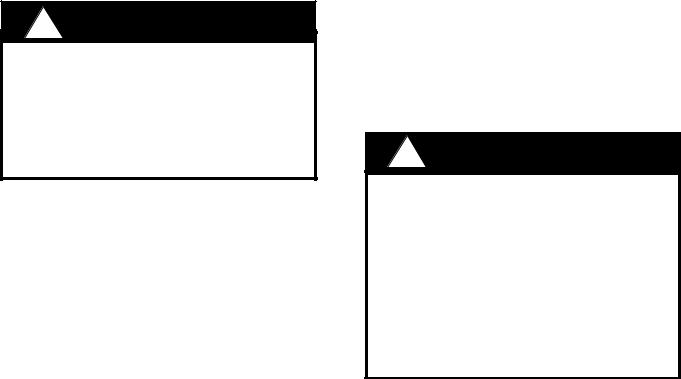
RÈGLEMENTS D'ÉVACUATION
Confirmer la sortie d'évacuation - soit par le mur, soit par le toit.
Utilisezunelongueurdetuyauterieminimaleaveclesmoindres de coudes pour la plus grande efficacité. Le diamètre de tuyauterie doit être uniforme. N'installez jamais 2 coudes ensemble. Scellezbientouslesjointsavecunrubanadhésif métallique à l'intérieur et scellez bien le clapet extérieur avec du calfeutrage.
Utilisez un tuyau d'évacuation rigide lorsque possible.
Untuyauflexibleégaledeuxfoisplusqu'untuyaurigide, ce qui réduit la puissance d'évacuation.
Veillez à ce que l'espace pour le tuyau soit ample - ainsi on n'aurait pas besoin de découper les supports de mur intérieur. Si ce découpage est nécessaire, veillez bien à ce qu'un renforcement soit mis en place.
Pour de meilleurs résultats, utilisez un tuyau de transition de 9 pouces dès que possible.
RÈGLEMENTS D'ÉVACUATIONADDITIONELL-PAGE8.
AVERTISSEMENT - Pour Ne Pas Risquer Un Feu, Utilisez Seulement Les Matériaux Métalliques.
Installations pour régions à climat froid
Ondevraitinstallerunclapetantirefluxadditionnelpourminimiserle refluxd'airfroid,etincorporerunélémentnonmétalliqued'isolation thermiquepourminimiserlaconductiondechaleurparl'intermédiaire du conduit d'évacuation, de l'intérieur de la maison à l'extérieur. Le clapetanti-refluxdoitêtreplacéducôtéairfroidparrapportàl'élément d'isolationthermique.L'isolantthermiquedoitêtreaussiprocheque possible de l'endroit où le système d'évacuation s'introduit dans la partie chauffée de la maison.
! AVERTISSEMENT
•Lesystèmed'évacuationDOITsortiràl'extérieur.
•N'ÉVACUEZPASleconduitsoitdansune mansarde soit dans un espace enfermé.
•N'UTILISEZPASunclapetdeséchoirà4pouces.
•N'utilisezpasunconduitflexible.
•N'ENCOMBREZPASlacirculationd'air.
•Fautedesuivrecetavertissementpourrait occasionner un feu.
FICHE TECHNIQUE ÉLECTRIQUE
Le raccordement électrique doit se faire avec un circuit séparé de 15 ampères fusible à 120V, 60 Hz, courant alternant. On recommande un coupe-circuit. La taille du fusible doit se conformer aux codes municipaux suivant la spécification électrique sur la plaque intérieure. Le diamètre du fil devra aussi se conformer aux règlements du code national
électrique, ANSI/NFPA 70 - ainsi qu'aux règlements locaux et les spécifications de cet appareil. On peut obtenir ces informations chez:
l'Association Nationale de la Prévention du Feu
Batterymarch Park
Quincy, Massachusetts 02269
Raccordezcetappareildirectementaucoupe-circuitavecunfil flexibllecouvertencuivreenlaissantunpeudelâchementdans lefilpourpermettreledéplacementdel'appareil. Veillezace qu'un contact d'un demi-pouce (1/2 po.) soit installé à chaque bout de fil (soit à l'appareil ainsi qu'à la boite à fusible).
Faites un trou de 1 1/4 po. dans le mur. S'il s'agit d'un trou en bois - sablez-le bien, tandis qu'un trou passant par le métal demande un bouche-trou.
AVERTISSEMENT - POUR RÉDUIRE LE RISQUE D'INCENDIE OU DE CHOC ELECTRIQUE, ne pas utiliser ceventilateurenconjonctionavecundispositifderéglage de vitesse à semi-conducteurs.
AVERTISSEMENT – POUR MINIMISER LES RISQUES D’INCENDIE, CHOC ÉLECTRIQUE OU DOMMAGES CORPORELS, OBSERVER LES PRESCRIPTIONS SUIVANTES: Suivez les recommandations du fabricant et entre en communication avec lui pour toute information.
Fermez le courant avant tout entretien et veillez a ce qu'il reste fermé. Si on ne peut pas verrouiller le panneaux du service électrique, affichez un avis de danger sur la porte.
AVIS: Pour L'évacuation Générale - Veillez à Ne Pas Evacuer Des Matériaux Ou Vapeurs Explosif.
AVERTISSEMENT – POUR MINIMISER LES RISQUES D’INCENDIE, CHOC ÉLECTRIQUE OU DOMMAGES CORPORELS, OBSERVER LES PRESCRIPTIONS SUIVANTES:L'installationEtLeRaccordementElectrique
Doivent Se Faire Par Un Technicien Qualifié Selon Tous
Les Codes Municipaux.
Afind'obtenirunrendementmaximalencequiatraitàla combustionainsiqu'àl'évacuationdesgazparlaconduite de cheminée, une bonne aération est nécessaire pour tous les appareils à combustion. Suivez les conseils et mesures de sécurité du fournisseur tels que ceux publiés par l'Association Nationale de la Sauvegarde contre l'Incendie et l'Association Américaine d'Ingénieurs de Chauffage, Frigorifaction et Air Climatisé ainsi que les codes municipaux.
En perçant un mur veillez à ne pas perforer un autre fil
électrique.
!AVERTISSEMENT
•Une prise à terre est nécessaire pout cette hotte.
•N'utilisez pas un tuyau à l'eau froide pour la mise
àterre s'il est branché à un joint plastique, nonmétallique ou autre.
•NE JOIGNEZ PAS la mise à terre à conduit de gaz.
•N'INSTALLEZ PAS un fusible dans le circuit de mise à terre - ce qui peut causer une secousse électrique.
•Vérifiez avec un électricien certifié à ce que la hotte soit bien mise à terre.
•Faute de suivre ces recommandations pourrait occasionner un feu.
Uniquement pour usage menager.
Version 09/12Page 3
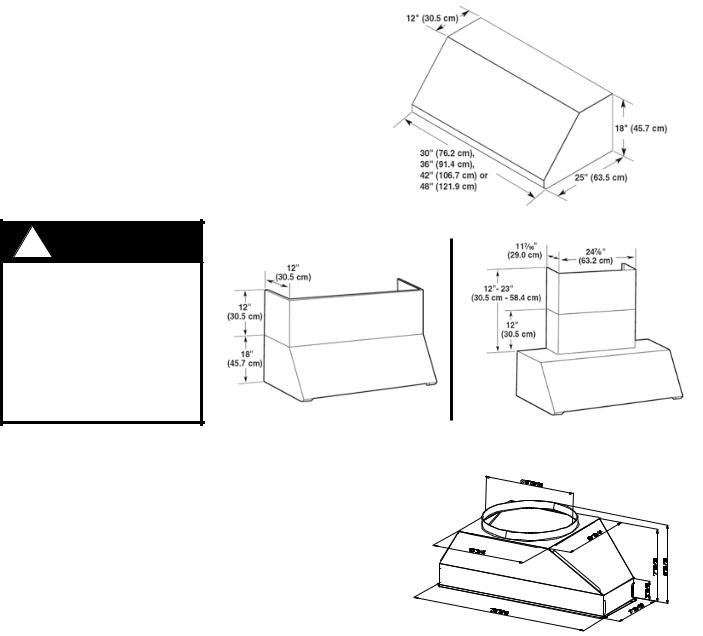
CAUTION
To reduce risk of fire and to properly exhaust air, be sure to duct the air outside – Do not vent exhaust air into spaces within walls or ceilings or into attics, crawl spaces, or garages.
TOOLS NEEDED FOR INSTALLATION
PLAN THE INSTALLATION
WARNING! BEFORE MAKINGANY CUTS OR HOLES FOR INSTALLATION, DETERMINE WHICH VENTING METHOD WILL BE USEDAND CAREFULLY CALCULATEALL MEASUREMENTS.
Parts supplied in range hood package:
•Saber Saw or Jig Saw
•Drill
•1 1/4" Wood Drill Bit
•Pliers
•Phillips Screwdriver
•Flat Blade Screwdriver
•Wire Stripper or Utility Knife
•Metal Snips
•Measuring Tape or Ruler
•Level
•Pencil
•Caulking Gun
•Duct Tape
PARTS SUPPLIED FOR INSTALLATION
Remove parts from packages. Check that all parts are included.
• 2 metal grease filters for 30" (76.2 cm) models
• 3 metal grease filters for 36" (91.4 cm) models
• 3 metal grease filters for 42" (106.7 cm) models
• 4 metal grease filters for 48" (121.9 cm) models
• 2 mounting brackets with adjustment screws installed
• 2 mounting bracket screws
• 4 washer head Phillips mounting screws
• Damper
• 2 dampers for 48" (121.9 cm) model.
PRODUCT DIMENSIONS
•1 Hardware Package
•1 Literature Package
PARTS NEEDED FOR INSTALLATION
•2 Conduit Connectors
•Power Supply Cable
•1 Wall or Roof Cap
•All Metal Ductwork
! WARNING OPTIONAL FULL WIDTH DUCT COVER OPTIONAL TELESCOPIC CHIMNEY
PERSONAL INJURY HAZARD
Becauseoftheweightandsize of the rangehood canopy, two or more people are needed to move and safely install the rangehood canopy.
Failuretoproperlyliftrangehood could result in damage to the product or personal injury.
CALCULATE THE DUCTRUN LENGTH |
|
|
|
The ductrun should not exceed 50 equivalent feet |
|
|
|
45˚ Elbow |
3.0 feet |
||
if ducted with the required minimum of 6" round |
90˚ Elbow |
5.0 feet |
|
ductwork (TWO - 6" ROUND DUCTS FOR 48" |
90˚ Flat Elbow |
12.0 feet |
|
MODEL - 75 equivalent feet for 1200 |
|||
cfmmodel). Calculatethelengthoftheductwork |
Wall Cap |
0.0 feet |
|
by adding the equivalent feet in FIGURE 1 for |
FIGURE 1 |
|
|
each piece of duct in the system An example |
|
|
|
|
|
|
|
is given in FIGURE 2. |
|
|
|
9 Feet Straight Duct |
9.0 feet |
||
For best results, use no more than three 90° |
2-90˚Elbows |
10.0 feet |
|
elbows. Makesurethatthereisaminimumof |
WallCap |
0.0 feet |
|
24" of straight duct between elbows if more |
Total System |
|
|
19.0 feet |
|||
than one is used. Do not install two elbows |
FIGURE 2 |
||
together. If you must elbow right away, do it |
|
|
|
as far away from the hood's exhaust opening |
|
|
|
as possible. |
|
|
|
10" DUCT TRANSITION
Version 09/12Page 4
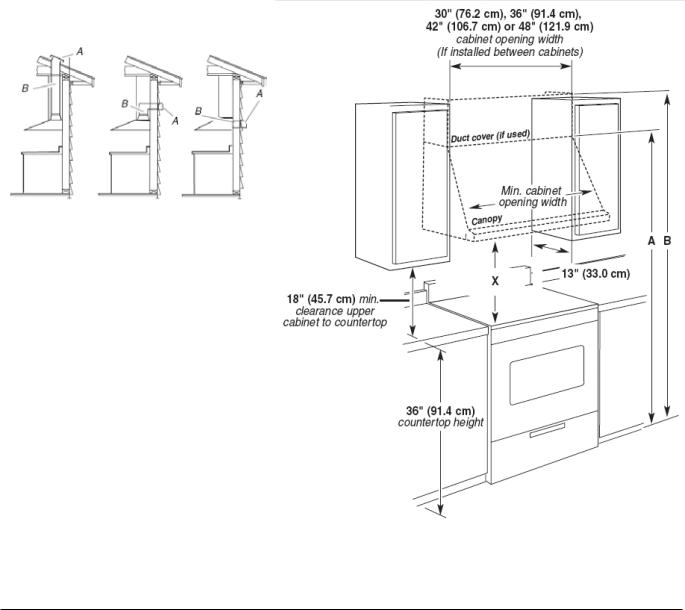
|
VENTING METHODS |
INSTALLATION DIMENSIONS |
Roof Venting |
Wall Venting |
Rear Venting |
A.Roof cap
B.6"roundvent
NOTE:Flexibleventisnotrecommended.Flexiblevent creates back pressure and air turbulence that greatly reduce performance.
Vent system can terminate either through the roof or wall. The exhaust collar can also be directed to vent out the rear of the hood.
Toventthroughthewall,theblowerneedstobechanged to the proper orientation.
*The 48" hood uses two 6" round vents or transitions to 10" round vent using #TRNSPRO
A.84"MINIMUMFORINSTALLATIONSWITHCANOPYONLY
B.96"MINIMUMFORINSTALLATIONSOPTIONALDUCTCOVERS
IMPORTANT:
Minimumdistance“X”:30"(76.2cm)
Suggestedmaximumdistance“X”:36"(91.4cm)
Full-Width Duct Cover
Accessories
Order Part Number FULL30 for 30" model
Order Part Number FULL36 for 36" model
Order Part Number FULL42 for 42" model
Order Part Number FULL48 for 48" model
Telescopic Chimney Kit
Order Part Number TELEMAES
10" round Duct Transition Kit
Order Part Number TRNSPRO
Version 09/12Page 5
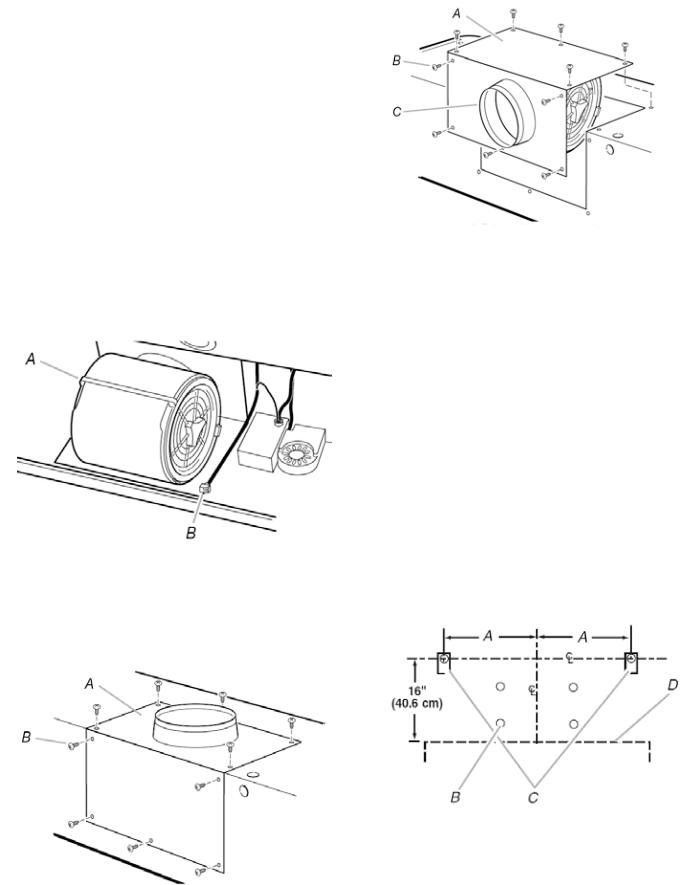
PREPARE THE WALL
1.Disconnect and move freestanding range from cabinet openingtoprovideeasieraccesstouppercabinetandrear wall. Put a thick, protective covering over cooktop, set-in range or countertop to protect from damage or dirt.
2.It is recommended that the vent system be installed beforehoodisinstalled.Beforemakingcutouts,makesure thereisproperclearancewithintheceilingorwallforexhaust vent.Checkthatallinstallationpartshavebeenremoved from the shipping carton. First, disconnect power.
Then determine which venting method to use: roof, wall or rear exhaust.
3. Rotate the blower assembly so that the exhaust collar is facing out the back of the hood.
CHANGING HOOD TO OPTIONAL REAR EXHAUST
The hood comes from the factory with the exhaust
collar on top of the hood. The hood exhaust may be directed out the rear of the hood through the exhaust collar. If you desire to have the hood exhaust out the rear, follow the procedure below.
1. From inside the hood, unplug wire attached to blower motor.
A. Exhaust blower assembly
B.Screws
C.Exhaustcollar
4. Replace the screws holding the blower assembly to the hood.
5. Plug the blower motor wire back into the blower motor.
A.BlowerMotor
B.Blowermotorplug
2.Turn the hood over and remove the screws holding the exhaust blower assembly to the hood.
A.BlowerMotor
B.Screws
RANGE HOOD MOUNTING SCREWS INSTALLATION
The hood attaches to the wall with two mounting brackets withadjustmentscrewsandfourmountingscrews.
1.Determine and mark the centerline on the wall where the canopy range hood will be installed.
2.Select a mounting height between a minimum of 30" and a suggested maximum of 36", above the
cooking surface and the bottom of the range hood. To this distance, add 16" and mark a horizontal line.
3.Mark 2 points on each side of the horizontal line the distance shown in “A” below (based on the size of your range hood).
A:Distance from center of mounting bracket to centerline: 30" hood: 13 3/8" / 36" hood: 16 3/8" /
42"hood:197/16"/48"hood:223/8"
B:MountingScrews(4)
C:Mountingbracketsandadjustmentscrews
D:Bottomofhood
4.Adjustthetwoadjustingscrewsonthemountingbrackets to the lowest point and attach to the wall with the screws provided. The screws provided for mounting this hood must be fastened into solid wood. Do not fasten into sheet rock only.
